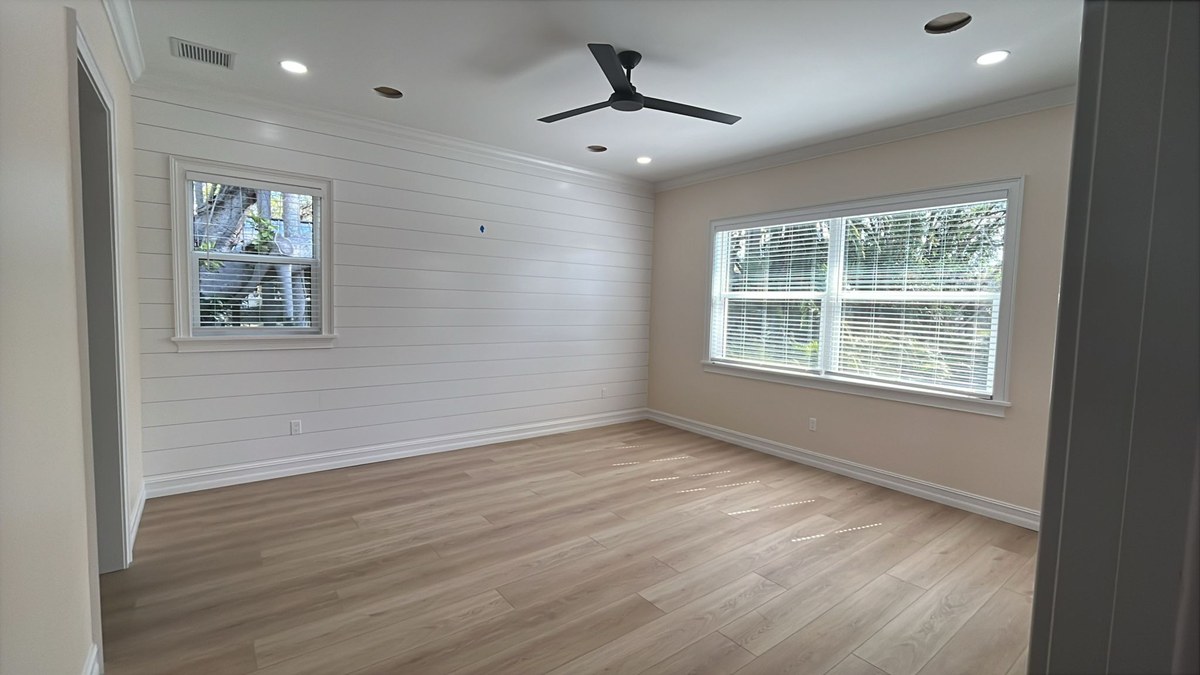Ever wonder why that perfect paint color you picked out looks totally different on your walls? You’re not imagining things. The lighting in your home has a huge impact on how paint color appears. If you’re about to start an interior painting project, change a light fixture, or even swap out bulbs, understanding how paint color and lighting work together will save you time, money, and frustration.
Key Takeaways:
- You’ll learn how lighting can completely transform the way paint colors look in your space.
- You’ll understand the difference between natural and artificial light, and how each one impacts your color choices.
- You’ll discover how the direction your room faces affects color perception throughout the day.
- You’ll gain practical tips on testing paint samples in your actual lighting conditions.
- You’ll be able to choose the right bulbs to enhance your paint color and achieve the look you want.

Why Does Lighting Change Paint Color?
Paint doesn’t physically change color once it’s on your wall—what changes is how your eyes see it. That perception is heavily influenced by lighting. Light contains color itself, and depending on its source and intensity, it can either enhance or distort the way a paint color appears. For instance, the soft glow of morning sunlight can make a neutral beige look rosy, while harsh midday light might make it feel washed out.
Artificial lights also have different color temperatures, which can dramatically warm up or cool down a color. Even shadows, reflections from furniture, and window placement all play a role in how that color registers to your eye.
Understanding this complex dance between paint and light helps you avoid surprises and choose a color that consistently looks great in your space.
Paint Color and Lighting: Natural vs. Artificial Light
Let’s break it down:
Natural Light changes throughout the day and is affected by the direction your room faces:
- North-facing rooms: These spaces receive soft, indirect light that leans cool. Because of this, colors tend to look more subdued, and cool tones can feel even chillier. To counterbalance this effect, it’s smart to use warm hues like creamy whites, soft yellows, or warm grays that bring in some coziness.
- South-facing rooms: These rooms are bathed in warm, bright light all day, making them the most forgiving when it comes to paint colors. Almost any shade works, but keep in mind that already-warm tones can feel more intense. Cool colors, on the other hand, help balance the warmth and create a more relaxing vibe.
- East-facing rooms: These get strong morning light that’s warm and golden, followed by cooler, softer light in the afternoon. Paint colors in these rooms can shift dramatically throughout the day. Soft pastels or light neutrals often work best because they feel pleasant no matter the lighting.
- West-facing rooms: Morning light here is minimal, but afternoons bring in a rich, warm glow. This can make warm paint colors feel even warmer—sometimes overly so. Muted or cooler tones are often a great choice to maintain balance and avoid an overly orange or red cast.
Artificial Light depends on the type of bulb you use:
- Incandescent bulbs: These traditional bulbs emit a soft, yellowish light. They boost the richness of warm colors like red, orange, and gold but can make cooler shades like blue and gray look muddy or dull. They’re great for creating a cozy, inviting atmosphere.
- Fluorescent bulbs: Often found in basements or older fixtures, these bulbs give off a bluish tint that enhances cool colors but tends to wash out warmer ones. They can make warm colors look flat and sometimes even harsh, so they’re not ideal for cozy spaces.
- LED bulbs: Versatile and energy-efficient, LED bulbs come in a range of color temperatures from warm white (like incandescents) to bright daylight. This flexibility allows you to tailor your lighting to your space and your paint color. For example, daylight LEDs work well with crisp whites and cooler tones, while warm LEDs complement earthy neutrals and warm shades beautifully.
How to Choose Paint Colors That Work With Your Lighting
1. Start With Samples
Don’t rely on paint chips alone—they’re too small and often misleading. Use actual paint samples or peel-and-stick swatches in your space. Apply them to multiple walls so you can see how the color behaves in areas that get more or less light. This step helps you avoid costly repainting down the line.
2. Check at Different Times
Colors can shift significantly throughout the day. View your samples in the morning, midday, and evening to see how both natural and artificial lighting affect them. Turn on overhead lights and lamps at night to get the full picture of how the color performs across 24 hours.
3. Think About Light Temperature
Light bulbs come in different color temperatures, from warm (yellowish) to cool (bluish). This can change the feel of your paint. For example, soft white bulbs might give your walls a golden glow, while daylight bulbs can make the same paint appear crisp and modern. Matching the bulb temperature to the mood you want is key.
4. Match Mood With Color
Paint color and lighting can work together to shape the mood of a room:
- Want a calming, spa-like feel? Go for cooler tones like pale blues, muted greens, or soft grays paired with diffused or daylight lighting.
- Want warmth and energy? Choose cozy colors like terracotta, buttery yellow, or rich beige, and complement them with warm-toned bulbs or golden afternoon light.
- Need flexibility? Go with versatile neutrals and install dimmable LED bulbs to shift the room’s vibe based on the time or occasion.
5. Consider Paint Finish
The sheen of your paint also plays a major role in how it looks under different lighting. Glossy and satin finishes reflect more light, which can make colors appear bolder and more intense. Flat or matte finishes absorb light, softening the look of your paint and minimizing imperfections on the wall. Choose based on the effect you want and the lighting intensity in the room.

Common Mistakes to Avoid
- Choosing a color based only on a paint chip: Paint chips are small and printed, not painted. They don’t reflect how color looks on a large wall or under different lighting. Relying on them alone can lead to disappointment when the final result doesn’t match your expectations.
- Not testing the color in your actual room: Lighting, shadows, and existing decor all influence how a color appears. If you skip testing paint samples in your space, you might miss how drastically a color can shift during different times of day.
- Ignoring the type of lighting in your space: Natural and artificial light affect paint color in different ways. A color that looks perfect in daylight might appear washed out or overly warm under your indoor lights. Always consider your lighting setup before committing.
- Using mismatched bulbs throughout the house: Using bulbs with different color temperatures in the same space can throw off how paint appears, making one wall look cooler and another warmer. Stick with consistent lighting to maintain color accuracy across the room.
Final Thoughts
Choosing the right paint color isn’t just about picking a shade you like—it’s about making sure that shade works with your lighting. When you take the time to test and understand how paint color and lighting interact, you’ll end up with rooms that look and feel exactly the way you want.
Need Help Picking the Perfect Paint?
Not sure where to start? That’s what we’re here for. At AA Total Painting, our friendly paint and color experts are ready to help you choose the perfect shades that match your lighting, your style, and your space. Whether you’re painting one room or your whole home, we’ll make sure you feel confident in your decision.
Give us a call at 813-736-5068 and let’s turn your ideas into a home you love coming back to every single day!


